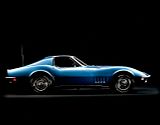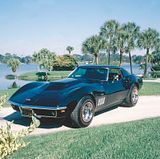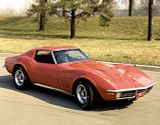| year by year |
1953 - 1962
First generation Corvette...


|
1963 - 1967
Second generation Corvette...


|
1968 - 1982
Third generation Corvette...


|
1984 - 1996
Fourth generation Corvette...


|
1997 - 2004
Fifth generation Corvette...


|
2005 - Present
Sixth generation Corvette...


|
Future
Seventh generation Corvette...


|
 |
|
| |
Third Generation Corvette Models 1968 - 1982 (C3)
The Year by Year Specifications:
The third generation Chevrolet Corvette, patterned after Chevrolet's "Mako Shark" (designed by Larry Shinoda), started in 1968 and ended in 1982. This generation has the distinction of being introduced to the motoring public in an unorthodox — and unintended — fashion. 1968 marked the introduction of Mattel's now-famous Hot Wheels line of 1/64-scale die cast toy cars. General Motors had tried their best to keep the appearance of the upcoming car a secret, but the release of the Hot Wheels line several weeks before the Corvette's unveiling had a certain version of particular interest to Corvette fans: the "Custom Corvette", a GM-authorized model of the 1968 Corvette.
In 1969, GM enlarged their small-block again to 350 ci (5.7 L), and in 1970 the 427 big-block was enlarged to 454 ci (7.4 L). Power peaked in the 1970 and 1971 models, with the 1970 LT-1 small-block putting out 370 hp and the 1971 454 big-block having its last year of big power with 425 hp. In 1972, GM moved to the SAE Net measurement for power (away from the previous SAE Gross standard), which resulted in lower values expressed in hp. Along with the move to unleaded fuel, emission controls, and catalytic converters, power continued to decline and bottomed out in 1975 — the base ZQ3 engine put out 165 hp, and the optional L82 engine put out 205 hp. Power remained fairly steady for the rest of the C3 generation, ending in 1982 with the 200 hp L83 engine.
Styling changed subtly over the generation. In 1973, the Corvette dropped the front chrome bumpers for a urethane-compound "5 mph" bumper but kept the rear chrome bumpers. In 1974, The rear chrome bumpers became urethane, too, making 1973 the last Corvette model year with any chrome bumpers. 1975 was the last year for the convertible, and 1978 saw the introduction of a glass bubble rear window. In 1980, the Corvette got an integrated aerodynamic redesign that resulted in a significant reduction in drag.
- For 1968, a factory installed anti-theft alarm system was available as an option, but less than 400 cars were so equipped.
- Pontiac almost beat Chevrolet to the Coke bottle design body, with their 1965 Banshee, a two seater convertible sports car that would have been hefty competition for the Corvette. GM stopped it, and then Pontiac president John DeLorean later became president of Chevrolet.
- T-top does not refer to the shape of the roof, but rather it is short for Targa Top. The original design was a pure Targa but body flex demanded the center bar, discovered late in the design.
- Due to policy changes at Chevrolet, Corvette was treated like all other car lines for the first time, and quality dropped drastically. With bad publicity in most magazines, policy was re-thought and Chevrolet quickly restored independence and higher quality to Corvette production within a few months. Many believe that all 1968 models still carry the stigma of having "the worst quality" of all Corvettes.
- In 1968, all big block manifolds were redesigned to actually sink into the lifter valley as the hood clearance was less than in '67 and earlier models. As such, a 1965 to 1967 big block intake manifold won't fit in a 1968 or newer Corvette with a stock hood and air cleaner.
- The exception to the above was the L-88. It retained the high rise manifold and also received a special hood, which was externally different to the regular big block hood.
- Emission control equipment was installed on the first 1968 models in the fall of 1967 even though the federal law required it only as of January 1, 1968.
- 1968 was the first year an AM/FM stereo radio was offered as an option
- The "Sting Ray name" was not used on the 1968 Corvette, but returned in 1969, this time spelled "Stingray" as one word.
- Corvette had its first all aluminum engine in 1969 as the ZL-1. It was not the first GM automobile to do so, however, being beaten by the Corvair in 1960 and the Buick 215 V8.
- Only two 1969 Corvettes were sold with the ZL-1 all aluminum 427 engine, making them one of the rarest collector Corvettes of all time. Note: Visit Roger's Corvette Center in Orlando, Florida, for a close-up look at an original 1969 ZL-1.
- In 1969, the ignition lock was moved from the dash to the steering column. It would remain there until 1997 when it was returned to the dash.
- In 1970, big block engines increased from 427 to 454 cubic inches and the powerful 370 HP LT1 small block engine made its debut.
- 1970 sales were their lowest since 1962 (only 17,316 units) due to a late start in the production year.
- The first ZR1 performance package appeared in 1970 (not 1990, as some might believe) and included the 370 HP LT1 engine and a host of other performance items.
- 1971 was the last year for fiber optic warning lights, first introduced in 1968.
- The only external difference between the 1971 and 1972 Corvettes is the amber front turn signals and chrome plating on the egg-crate grills on the 1972.
- 1972 was the only year for Corvette "Big Block" engines in the 1968 to 1972 range to have no horse power sticker on the air cleaner lid.
- Beginning in 1972 and continuing thereafter, horsepower would be measured as "net" rather than the less realistic "gross" ratings of earlier years.
- "Pewter Silver" was only offered as an exterior color in 1972.
- 1972 was the only year air conditioning was available with the LT1 engine and since only 240 were so equipped, this combination is a rare find today.
- Although 1973 VIN's run to 34464, only 30,464 units were built; the 4,000 serial numbers between 24001 and 28000 were never used.
- The 1970 - 1972 Corvettes were the last to feature chrome bumpers front and rear. In 1973, due to front impact legislation requirements, the front bumper was changed to a body-colored flexible plastic. In 1974 the rear bumper followed suit.
- In 1973, aluminum wheels were again listed as an option. However, their inability to maintain air pressure (much like the problems which plagued the early 1963 aluminum knock off wheels), kept them out of the hands of customers until 1976.
- The rear view mirror in the 1974 Corvette was increased to a width of 10 inches.
- The last true dual exhaust was installed in 1974. After that, all exhaust gases were channeled through a single catalytic converter.
- The 1974 rear "rubber" bumper was made in 2 pieces due to shortcomings in the manufacturing process. The process was improved the following year, thus 1975-1982 models used a one piece unit.
- The big block engine made it's final curtain call in the 1974 Corvette.
- The FE7 Gymkhana Suspension package was first introduced in the 1974 Corvette.
- 1974 was the last year the Corvette would be produced to run on "leaded" gasoline.
- 1975 was the first year for a HEI distributor.
- The convertible was discontinued after the 1975 model year and would not reappear again until 1986. GM cited declining sales for convertibles (only 4,629 units in '75) and safety concerns as reasons for killing the ragtops.
- 1976 Corvette used the same steering wheel as a Chevrolet Vega for the "Sport Steering Wheel" Option.
- Due to stricter emissions standards, California Corvette buyers could not opt for the L82 engine in 1976.
- The 500,000th Corvette, a white 1977 coupe, rolled off the St. Louis assembly line at 2:01 P.M. on March 15th, 1977.
- 1977 was the last year for the notch back roof line.
- The aftermarket "Moon Roofs" (glass t-tops for Corvettes) were supposed to be optional equipment in 1977, but the manufacturer had a marketing dispute with Chevrolet. GM developed their own glass panels for the 1978 model year.
- The 1978 model saw the first fastback rear window since 1967.
- The 1978 Pace Car's distinguishing "Black and Silver" paint was chosen over other alternative color schemes primarily because it photographed well. Back then, most magazine articles and ads were still done in Black & White!
- Crossed flag emblems returned to the nose and sides of the Corvette in 1979.
- More Corvettes were built in 1979 than in any other year, before or since... a total of 53,807 units were produced.
- Due to tougher emission standards, Corvettes bound for California were fitted with 305 cubic inch engines.
- The 305 cubic inch V-8 installed in 1980 California-bound Corvettes was the first Corvette engine to be monitored by a computer. Since 1981, all Corvettes have been computer equipped.
- By Federal mandate, the 1980 Corvette was the first Corvette to have a speedometer with an upper limit of only 85 MPH.
- There were no optional Corvette engines in 1981.
- The 1981 Corvette had two cooling fans to increase engine power.
- In 1981, Corvettes were produced with two different types of paint. Lacquer was applied at the St. Louis plant, and enamel was applied at the new Bowling Green plant.
- In 1982, console mounted clocks were quartz units and had the word "QUARTZ" printed on the face, while the 80-81 years did not.
- In 1982 fuel injection reappeared in the Corvette after a 17-year hiatus.
- For the first time since 1954, in 1982 you could not order a Corvette with a manual transmission.
| Year |
Production |
Base Price |
Notes |
| 1968 |
28,566 |
$4,663 |
First C3 Sting Ray; 2-piece T-tops are new |
| 1969 |
38,462 |
$4,780 |
First year of the 350 in³ Small-Block; Now called Stingray |
| 1970 |
17,316 |
$5,192 |
First year for the LT1 Small-Block and 454 in³ Big-Block |
| 1971 |
21,801 |
$5,496 |
Significant hp drops |
| 1972 |
27,004 |
$5,533 |
Last year for front chrome bumpers, the LT1, and the optional removable rear window |
| 1973 |
30,464 |
$5,561 |
Only year with chrome rear and plain front bumpers |
| 1974 |
37,502 |
$6,001 |
Plastic bumpers all around; last year of the 454 |
| 1975 |
38,645 |
$6,810 |
Catalytic converters are new; last year of the convertible until 1986; new (simulated) pads stick out of the bumpers |
| 1976 |
46,558 |
$7,604 |
Few changes |
| 1977 |
49,213 |
$8,647 |
New interior console |
| 1978 |
46,776 |
$9,750 |
Silver Anniversary and Indy 500 Pace Car versions; new fastback rear and redesigned instruments |
| 1979 |
53,807 |
$10,220 |
New interior comfort features; highest Corvette sales year to date |
| 1980 |
40,614 |
$13,140 |
Lightened materials and bumper-cap spoilers; 85 mph speedometer |
| 1981 |
40,606 |
$16,258 |
Production is switched from St. Louis to new Bowling Green plant |
| 1982 |
25,407 |
$18,290 |
No manual transmission offered; new cross-fire fuel-injected L83 engine; Collectors Edition hatchback is ¼ of total sales |
| Total |
542,741 |
|
|
| Engine |
Year |
Power |
| 327 in³ Small-Block V8 |
1968 |
300 hp |
| 1968–1969 |
350 hp |
| 350 in³ Small-Block V8 |
1969 |
300 hp |
| 1970 |
350 hp |
| 1970–1971 |
370 hp |
| 1971 |
270 hp |
| 1971 |
330 hp |
| 1972 |
200 hp net |
| 1972 |
255 hp net |
| 1973 |
190 hp net |
| 1973–1974 |
250 hp net |
| 1974 |
195 hp net |
| 1975 |
165 hp net |
| 1975 |
205 hp net |
| 1976–1977 |
180 hp net |
| 1976–1977 |
210 hp net |
| 1978 |
185 hp net |
| 1978 |
220 hp net |
| 1979 |
195 hp net |
| 1979 |
225 hp net |
| 1980–1981 |
190 hp net |
| 1980 |
230 hp net |
| 1982 |
200 hp |
| 427 in³ Big-Block V8 |
1968–1969 |
390 hp |
| 1968–1969 |
400 hp |
| 427 in³ Big-Block Tri-Power V8 |
1968–1969 |
435 hp |
| 454 in³ Big-Block V8 |
1970 |
390 hp |
| 1971 |
365 hp |
| 1971 |
425 hp |
| 1972, 1974 |
270 hp net |
| 1973 |
275 hp net |
|
               |
|
|
